What are the solutions currently in use by Kashrus Agencies? How successful are they?
These solutions started 100+ years ago and have evolved as each solution has been found to be inadequate.
The thieves naturally adapted to and found ways round the then current security measures.
The traditional method for ensuring Kashrus, in particular of meat, has been for the Mashgiach to attach some sort of 'seal' to the item. Originally, a wire was threaded through the meat - typically a whole chicken - and sealed with a 'plomb' - a piece of lead crimped onto the wire with a form of pliers which embossed a simple 'seal' in the form of a letter or shape.
This has evolved into various shapes of single-use plastic seals which are attached at an abattoir to chickens, turkeys and large pieces of meat. The plastic seal typically has the name and logo of the Kashrus Authority and is so constructed that the seal breaks if it is removed - it cannot be used again.
For their 'proof' of kashrus, they rely on Mashgichim guarding the seals from loss or theft - an obvious weakness of the system. It is also assumed that no forger will be motivated enough to go out and get identical seals made - another weakness of the system.
Plombas - Examples
Click on any image below to enlarge it.
Wire/Lead plombas

Plastic plombas
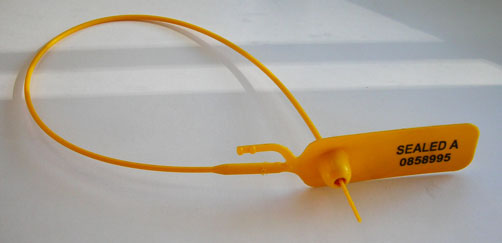
A recent 'advanced technology' product has appeared on the market - labels printed with various complex patterns:
- ultra-finely positioned graphical elements
- small complex arrangements of dots
- 5 pixel micro-text fonts
- structured halftones
- etc.
Note that such labels are significantly more expensive than even holograms.
We have seen such labels advertised with features that would put some paper currency designs to shame.
The problem again with this is that it may discourage but cannot stop counterfeiting. The labels can still be copied. Actually, even rough copies would suffice as the average purchaser cannot really tell what is and what is not a genuine label. Only after inspection with special tools and comparison with the master design, can one determine whether a label is genuine or not.
Such a label may be good for the Kashrus Agency to be able to prove, after the event, that a package was a counterfeit, but that is small consolation to the people who have purchased and eaten, maybe for months on end, non‑kosher food on the basis of what looked like a genuine guarantee of Kashrus.
These labels suffer from the same issues as described below for holograms.
Micro Text Examples
Wine bottle label with micro text
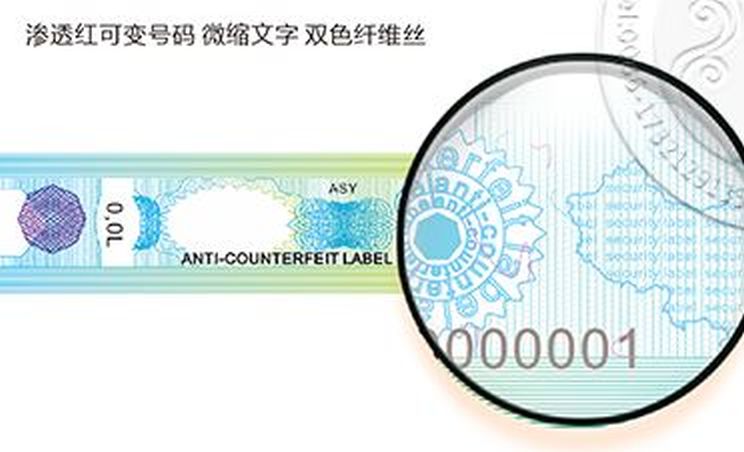
Recognising the high risks of forgery, especially with expensive items like meat, several Kashrus Authorities started some years ago to add 'security' labels in the form of Holograms.
How are they more secure than other labels? Some Kashrus Authorities will say that they are more expensive to forge and will thus better discourage forgery. Others, in all innocence, will even claim that they cannot be copied so they actually prove the item is genuine.
Unfortunately, both those claims are in error. The first claim sounds convincing until you ask the obvious question: "Will the loss of one cent profit per package stop a forger who is making several Dollars profit on every pack?"
The obvious answer is a resounding 'no'. As to the second claim, it is simply not true. All holograms can be copied at a relatively trivial cost - typically in the region of one cent.
More recently, recognising the deficiencies of the original product, the hologram industry has itself come up with even more sophisticated holograms - moving 3-D images that show four different images depending on how you rotate it. While they look impressive, their only real advantage is that they cost a bit more.
Holograms seem to be the current favourite for attaching to high risk articles. They give the appearance of 'something special' so the purchaser has a higher level of confidence in its being original. There is no denying that it has some deterrent value as it adds a cent or two to the cost of a forgery. This generally discourages 'opportunistic' forgery, but it certainly cannot stop it.
If the Kashrus Authority can afford to put a hologram on every packet then so can the forger.
In any event, the purchaser has no real way of knowing whether the hologram in his hands is real or not. Even a bad copy will look genuine. After all, it is a hologram!
As we have seen on the right hand side panel, the Kashrus Authority bulletins only advise the public along the lines of "Any package of product X that does not have a hologram is NOT under our Hechsher, even if our logo is displayed”. There is no attempt made to educate the public to differentiate between a genuine and fake hologram, as it is recognised to be an impossible task.
So while it may be a bit unfair to call holograms 'smoke and mirrors' [1], in reality they can at best discourage forgeries, they cannot stop them. If there is money to be made, then the cost of sourcing a suitable hologram will not deter the forger.
See below The Truth about Hologram and Enhanced Labels as to how these 'complex' labels actually play into the hands of the forger.
Holograms - Examples
Click on any image below to enlarge it.
Pack of meat with hologram

OU Hologram on a pack of cheese
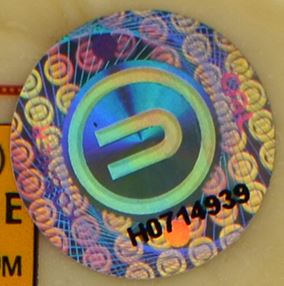
Above are some samples of holograms on meat and cheese packets.
They are being used as the Kashrus Authority involved considers such items as high-risk.
Now let us take a trip to alibaba.com where you will find hundreds of companies that will print for you any hologram you want at a price around 1 cent each. Click on the link and take a stroll. [alibaba]
Or just Google for "custom hologram printers" to find printers in the US, UK and the rest of the world who are capable of printing such labels. Even if they are the most principled of companies, and would not dream of producing forgeries, how many would be able to tell that the person placing the order is not actually authorised to do so.
The real facts: All Holograms and Enhanced Labels can be copied! Like any other printed label!
The forger just goes to a printer and pays around a cent per label. On a profit of $400 or even $100 or even $1, will the cost of an additional cent really put off a forger?
If that was the only problem, then at least Holograms and Enhanced Labels would be no worse than a simple label. Unfortunately, in place of providing some protection, Holograms used as Kashrus seals are positively dangerous! Not only can holograms not stop forgeries, they can, and actually do, help the forger in passing off his counterfeit product!
Over the years, to raise confidence and thus encourage use of Credit Cards, the Banks have 'sold' Holograms to the public as 'proof' that the card is 'genuine', knowing full well that in reality they prove nothing of the sort. The Banks have no problem with that. Their vast profits from the use of genuine credit cards more than compensates for their losses due to fraud. The net result of this is that the public believes that anything with a Hologram is guaranteed genuine.
Where does that leave Kashrus? Much worse off than without a Hologram!
The use of Holograms just strengthens the hand of the forger!
As long as he uses a hologram that is a near match to the original, a forger wins hands-down! The very tool that is being sold as an aid to stop forgers, actually makes forgery easier and more profitable. The deception can be kept running for much longer, as the public simply assumes: This product has a hologram - It must be genuine!
The forger does not even have to exactly match the original hologram. Something that looks like the original will be accepted as real, as a purchaser has no way of knowing what a genuine hologram actually looks like. Even when laid side by side he will not be able to differentiate - they both look equally 'fancy'.
This is the same issue as with regular packaging - can the consumer actually know what is and what is not genuine packaging? As long as it is a reasonably good copy it will be accepted. Manufacturers frequently change their packaging. Does the public stop buying the product fearing a forgery?Even with banknotes, used daily, very few people can actually spot a fake. All the fancy markings are there purely for the benefit of the professionals. They do not eliminate the risk faced by the average man in the street.
Have a look at the very interesting Nokia article on the right sidebar which should bring home the concepts we have just discussed.
The conclusion we must reach is that Holograms are not only ineffective, but rather they are counter-productive. Without a Hologram, a purchaser is at least forced to take a critical look at what he is buying and determine for himself what are the risks of the item being counterfeit (taking into account price, location and packaging), rather than being lulled into a false sense of security by a fake hologram.
Our conclusion as far as Kashrus is concerned: Holograms are dangerous! They teach the public to trust holograms, making it much easier for a forger to pass-off his goods as the real thing.
Nokia No Longer Bothering With Holograms
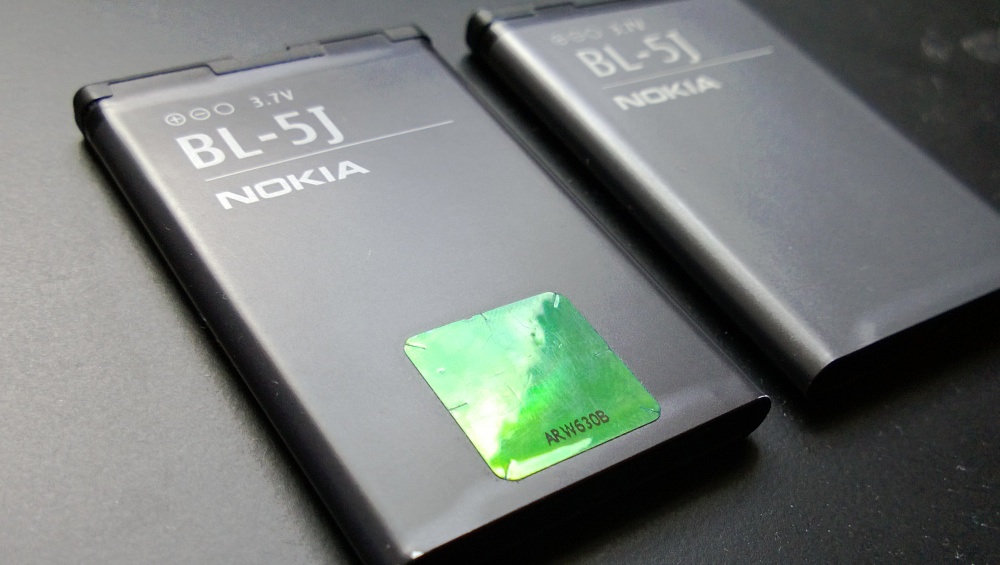
The image above shows two Nokia batteries - one with and one without a Hologram.
Can you tell which is genuine? Both? Neither? We don't know either!
The blog first bemoans the fact that Nokia no longer put Holograms on the replacement batteries.
But then it comes up with the most startling statement:
"In fact, the spare fakes currently being sold still have (fake) holograms, which is a huge ironic twist on the original concept of this security feature!
Maybe Nokia merely realised that the fake holograms were now so good that it wasn't worth persisting with the idea?"
The author is on the right track. Nokia realised that adding a Hologram was just playing into the hands of the forgers.
Better to have no Hologram and then let the purchaser decide, based on facts such as the reputation of the seller and the price, whether what was being offered was genuine or not.
With the millions of general kosher retail items produced today, the vast majority of the 'seals' have degenerated to being nothing more than a pre-printed Kashrus Authority logo.
This applies equally to a packet of salt, milk, cheese and meat.
With some high risk items, the Kashrus Authority may add a hologram to give an impression of raised security, but we have seen above the futility of such labels.
In virtually all cases, the packaging is sourced by the non-Jewish company making the product under supervision. There is no supervision possible that would somehow stop the manufacturer from using the same packaging on a non-supervised production. We seem to be relying on nothing more than the fear of the manufacturer being discovered and thereby losing business.
Forging these symbols is not at all difficult. To put it bluntly, it is extremely easy. Putting it even more bluntly, they require zero effort or financial expenditure as they are part of the necessary pre-printed packaging - all under the control of the non-Jewish factory.
As to the printing on the tin itself, which includes the name of the Kashrus Authority (blanked out), the production date, the best‑before‑end date and some batch numbers, what assurance of Kashrus does any of the printing provide?
It is printed by a machine that is programmed by the factory staff and whatever the machine prints on 250,000 kosher tins it can also print on any number of other tins - whether produced under supervision or made long after all the Mashgichim have gone home.
Where the potential profits are large enough or a suitable opportunity arises, production of counterfeit products becomes almost a certainty.
If we were being truthful to ourselves we would have to admit that all such 'seals' are nothing more than 'informational' and we all, unwittingly, just rely on them as 'proofs' in the hope that they are true.
Obviously, the forger need not be the original manufacturer. Any other company, seeing the success of a particular brand, can easily copy the packaging and distribute counterfeit copies.
We fail to understand how such packaging can be considered as complying with Halacha.
We have also seen the use of a paper label - see side panel - stuck on a tin of sardines. Its purpose is rather obscure, as it does not add any extra level of authenticity to the item. We suspect its purpose is to satisfy the Halacha's requirement for 'two seals' for fish, though we do not understand how this is actually achieved.
In any event, no one can claim that such seals guarantee kashrus in any way.
We have been told of a kashrus seminar where a Kashrus Authority representative told of a incident at a production run at a foreign location. Towards the end of the production, one of the factory workers whispered to the Mashgiach that he wanted to show him something when no one was around.
Later that day he took him to some outside area and opened a door and showed him a consignment of the same product that they had just supervised, with identical packaging and labelling as the kosher product.
A lovely story of "Siata D'Shmayo"? That is what the story teller had in mind, but to a suspicious mind it just conjures up a vision of all the other productions where the 'other consignment' was never discovered.
Boxed Sardines
Click on any image below to enlarge it.
Sardine box

Sardine tin label
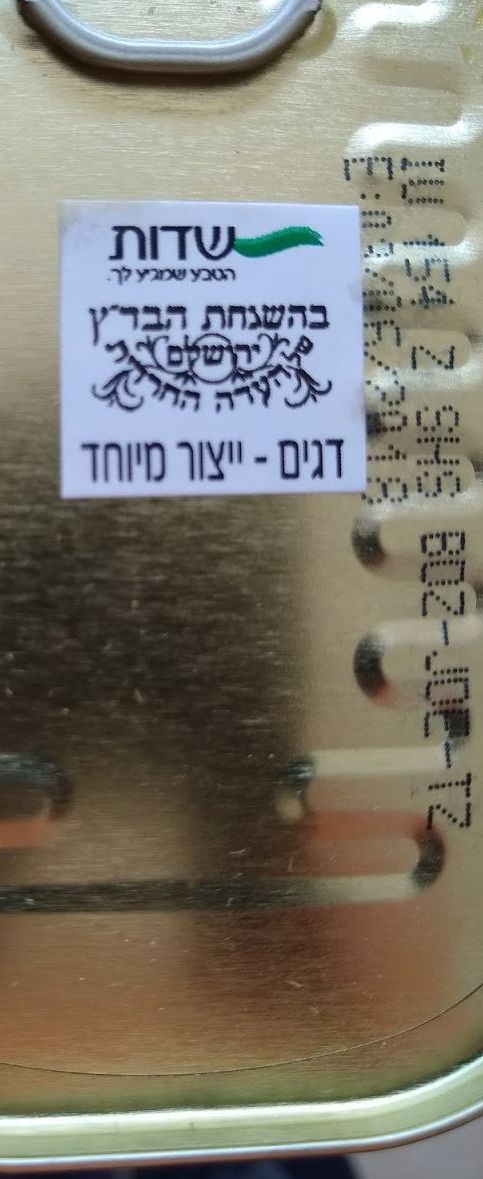
The top image shows the outer box with the Kashrus Authority logo.
The second image is of a Kashrus Authority label stuck to the inner tin itself.
Do either of those 'seals' somehow assure the purchaser that the tin is genuine?
Are either of them Halachic seals?
Sardine box with two Kashrus logos

Above is the box of a tin of sardines produced under two Kashrus Authorities. (We have blanked out the two logo-seals as the actual Kashrus Authority involved is not relevant to this discussion as they all work in virtually identical ways).

Above are the production codes as printed on the actual sardine tin.
It includes the name of the Kashrus Authority (blanked out) but what assurance of Kashrus does any of the printing provide?